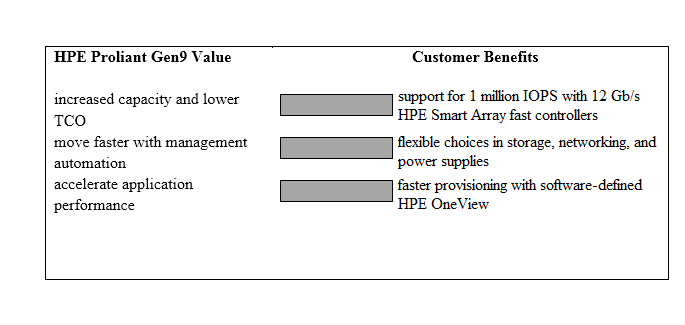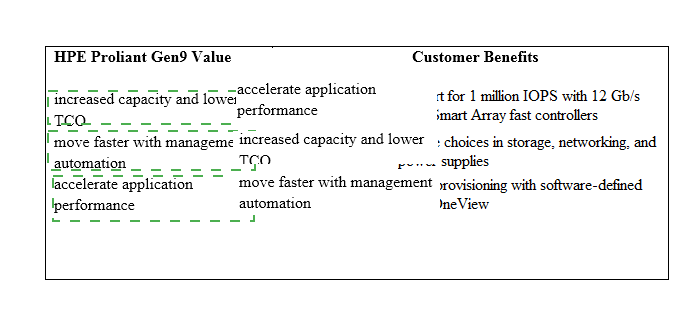Architecting HPE Server Solutions v8.0
Question 1
A customer has a VMware vSphere environment with a mix of ProLiant DL G5 servers.
ProLiant DL G5 servers, and ProLiant BL Gen9 server blades. The customer plans to replace HPE Insight Control with HPE OneView as a monitoring platform.
What should the architect explain to the customer?
- A. that HPE OneView does not support G5 and older servers
- B. that HPE Insight Control can be directly updated to the HPE OneView
- C. that HPE Insight Control does not support Gen9 servers
- D. that HPE OneView licenses must be purchased in 50 node bundles
Answer : B
Question 2
Which statement describes HPE Datacenter Care services?
- A. It provides advanced power management monitoring and support.
- B. It provides collaborative call management assistance for only x86 solutions.
- C. It is an alternative that provides hardware support only.
- D. It is a mix of enhanced call management, proactive services, and hardware/software assistance.
Answer : D
Question 3
A small business customer is moving to a stack solution and needs an HPE ProLiant server that provides dense storage, good performance, virtualization capability, and easy expansion at a lower price point.
Which HPE ProLiant server should the architect recommend to meet the customers needs?
- A. DL580 Gen8
- B. DL380p Gen8
- C. DL380 Gen9
- D. DL180 Gen9
Answer : C
Explanation:
HPE DL380 Gen9 is a unique system at lower price point that provides dense storage, amazing performance and virtualization solution with easy expansion.
Question 4
A solutions architect is designing an HPE ProLiant BladeSystem and HPE StoreVirtual storage solution for a customer, and needs to estimate power requirements.
Which HPE tool should the architect use?
- A. HPE Insight Management Sizer
- B. HPE OneView
- C. HPE Power Advisor
- D. HPE Power Discovery Services
Answer : C
Explanation:
HPE Power Advisor is the only tool available for ProLiant products to size power requirements and all things related to power management.
Question 5
A customer needs an OpenStack-based cloud datacenter with several virtual machines that will be placed in multiple VLANs. The customer needs to use Virtual Extensible LAN
(VXLAN)
Or Generic Routing Encapsulation (GRE) technology to support multi-tenant traffic. The architect recommends the following HPE server equipment:
Which rationale supports the architects recommended configuration?
- A. It allows RDMA over Converged Ethernet (RoCE)
- B. It improves performance of OpenStack instance provisioning
- C. It improves performance of overlay networks with a tunnel offload engine
- D. It allows configuration of interconnect module stacking
Answer : D
Question 6
A customer is designing an infrastructure and plans to host multiple tenants in the environment. The customer needs several thousand segments to be used on a single physical network.
Which solution should the customer use?
- A. Data Center Bridging
- B. Overlay networks
- C. Virtual Connect FlexFabric
- D. Remote Direct Memory Access
Answer : B
Explanation:
Overlay networks allow IT managers to scale their data center networks beyond the several thousand VLAN limit.
Question 7
Which functionality provides centralized health monitoring for HPE ProLiant servers?
- A. iLO Federation
- B. intelligent Provisioning
- C. HPE Insight Control server provisioning
- D. HPE System Management Homepage
Answer : C
Question 8
How does the HPE BladeSystem architecture meet the changing needs of data center customers?
- A. introduction of Active Health System monitor
- B. system management using HPE Virtual Connect modules
- C. enables customers to shift investment from maintenance to innovation
- D. consolidate deployment of firmware via HPE Agentless Management
Answer : B
Question 9
Select all that apply.
Click and drag the HPE Proliant Gen9 value on the left to match its customer benefit on the right.

Answer : 
Question 10
Which solution enables a customer to manage all operating system drivers and system firmware across the data center from one central location?
- A. HPE OneView with Federation Group license
- B. REST API with Embedded UEFO Shell scripts
- C. HPE Synergy Composer and HPE Synergy Image Streamer
- D. HPE Smart Update solution
Answer : D
Explanation:
Smart Update Manager (SUM) is an innovative tool for firmware and driver maintenance for
HPE ProLiant and Integrity Servers, BladeSystem and Moonshot infrastructure, and associated options. SUM allows the maintenance to come from the administrator at a console with a browser-based GUI versus having to physically touch each unit and staff travel time. SUM has an integrated discovery engine that finds installed hardware and current versions of firmware and software on target servers and identifies associated targets that should be updated in conjunction with each other, to avoid interdependency issues. It is preloaded with all relevant interdependency information from our lab testing before each Service Pack for ProLiant (SPP) release. SUM doesn't require an agent for remote installations because it copies a replica of itself to each of the target servers only for the duration of the installation.
Question 11
What is a feature of the Apollo 4200 series Gen9 Server?
- A. support for 50 SFF SAS Disk Drives
- B. optimization for nonstandard racks
- C. 3U height
- D. support for maximum 6G transfer rate
Answer : D
Question 12
A customer needs an HPE BladeSystem and iSCSi StoreVirtual storage that can boot from iSCSi volumes.
Which components must be included to meet customer requirements?
- A. HPE Virtual ConnectFlexFabric and Flex-10 LOM cards
- B. HPE Virtual ConnectFlex 10/10D and FlexFabric LOM cards
- C. HPE BLc 4x QDR InfiniBand Switch and FlexFabric LOM cards
- D. Brocade FibreChannel switch and additional HBA mezzanine cards
Answer : A
Explanation:
For understanding the approach to bandwidth tuning involves understanding the complete solution objectives and needs. HPE BladeSystem with HPE Virtual Connect Flex-10 or
HPE Virtual -
Connect FlexFabric present tunable network interfaces as physical adapters within vSphere thereby offering competing bandwidth allocation and enforcement opportunities than withvSphere. Management and deployment options will vary. In larger multiple HPE
BladeSystem environments,
HPE CloudSystem Matrix offers additional orchestration opportunities to leverage network bandwidth automation. It is also noted that 10GbE interfaces provide increased bandwidth options over 1GbE.
Question 13
Why does HPE OneView not affect operating systems security on monitored HPE ProLiant
Gen9 servers?
- A. It sets secure usernames and strong passwords in the server operating system.
- B. It uses iLO embedded SNMP stack to receive hardware alerts.
- C. It relies on Kerberos for health-related communications.
- D. It uses certificate-basedauthentication for health-related communications.
Answer : B
Explanation:
Select the SNMP setting Agentless Management (default). Use SNMP agents running on the iLO to manage the server. The iLO processor fulfills SNMP requests sent by the client to the iLO over the network. This setting does not affect alerts.
Question 14
A customer needs a high-level fault-tolerant solution for critical data. The customer uses eight large-capacity SAS drives as a single disk volume.
Which RAID level should the architect recommend to protect the customer against double drive failure?
- A. RAID 1 with a hot spare
- B. RAID 6
- C. RAID 5 with a hot spare
- D. RAID 5
Answer : B
Explanation:
RAID 6 (ADG) is an extension of RAID 5 for implementation on arrays of four or more drives. The data and two sets of parity information are striped across all drives in the array.
The additional set of parity improves the fault tolerance of the array but results in lower write performance. The two sets of parity information are stored in different locations across the drives in the array and occupy the equivalent capacity of two physical drives.
RAID 6 protects against the simultaneous failure of two drives in the array
Question 15
Which fabric benefit does Synergy have over BladeSystems?
- A. eliminates the need for Link Modules
- B. supports Fiber Channel over Ethernet
- C. eliminates the needfor a Top of Rack Switch
- D. provides redundant Top of Rack switches within one rack
Answer : C
Explanation:
The master module contains intelligent networking capabilities that extend connectivity to satellite frames through Interconnect Link Modules. The result being elimination of top of rack switch need, as any addition of new satellite frames are connected to the master module instead of ToR switch, and substantially reduce cost. The reduction in components also simplifies fabric management at scale while consuming fewer ports at the data center aggregation layer.